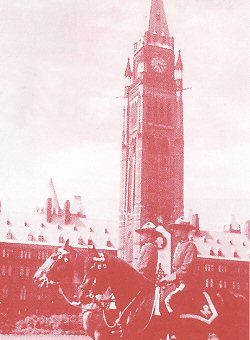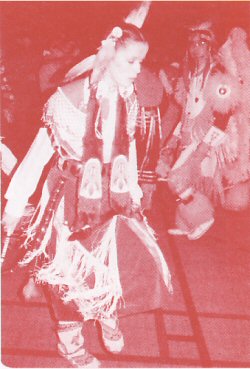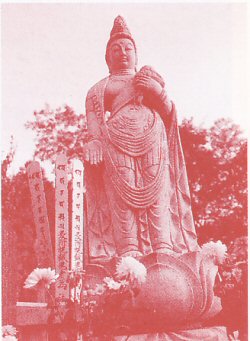CANADA: A Multicultural Nation
By Paul McKenna
December 1996
Return to Table of Contents
Print Article
For many people in our world, Christmas does not hold the meaning it does for us as Christians. For us it is a time to remember and celebrate Christ-the meaning of our lives. While most of the articles and stories in this issue recall Christ, the following article reminds us of a Canada that includes peoples of other cultures and faiths. Christ challenges us to be concerned and open to the other, to go to 'the other side.' For Pope John Paul II, dialogue between people of different faiths implies "concern; respect and hospitality toward the other." In dialogue, the Pope states, "we let God be present in our midst; for as we open ourselves in dialogue to one another, we also open ourselves to God."

The religious face of this planet is changing. At a dramatic pace, more and more regions of the world are becoming environments of multi-culture and multi-faith. Indeed, religious pluralism has proven to be one of the most extraordinary developments of the 20th century.
At the root of this phenomenon are international patterns of immigration. Throughout this century, the profound and world-wide movement of peoples and cultures has provoked a meeting of religions that is new to history. And this development has accelerated in the last 30 years. The 1990 Britannica Book of the Year reports that 14 major religions or religious systems are now present in some significance in more than 80 countries in the world.
But how are these changing religious demographics affecting Canada? The liberalization of immigration policy, begun during the Trudeau years, has served to transform the religious and cultural face of this country. It should be noted, however, that followers of many of the great world religions arrived in Canada long before the 1970s.
It was not until the Trudeau years, that the first Jews in Canadian history were appointed to the Federal Cabinet. However, the first Jewish immigrants to Canada arrived before the British and the British parliamentary system. Jews were among the earliest fur traders in the 1700s, and Canada's first synagogue, the Spanish-Portuguese synagogue in Montreal, was founded in 1768.
The first Buddhists to arrive in Canada may have been Chinese, landing in British Columbia as early as 1858, and the country's first Buddhist temple was founded in Vancouver in 1905. In June of 1996, the Presbyterian Church of Canada elected its first visible minority moderator, Tamiko Corbett, who is of Japanese descent and whose grandfather was one of the founders of the 1905 temple.
Most archeologists agree that there has been an Aboriginal presence in Canada for at least 12,000 years, and we are fortunate to be one of those countries that is enriched by the continuing presence of its First Nations peoples.
Clearly Canada has become a multi-cultural and multi-religious nation; in fact, we are pioneers in the creation of a multi-cultural society. Multiculturalism is protected by our laws; it is entrenched in our Charter of Rights and Freedoms; it is defended and, more importantly, funded by a special cabinet level government department.
Canada's Charter of Rights and Freedoms (1982) is meant to guarantee certain basic rights including freedom of religion and freedom of conscience. As well, the Canadian Multiculturalism Act of 1988 affirms the racial and cultural diversity of Canadians and requires all departments and agencies of the government of Canada to make multiculturalism part of their programs and policies. Three areas of government programming in this regard are: Race Relations & Cross-Cultural Understanding; Heritage Cultures & Languages; and Community Support & Participation.
As well, in February, 1994, the federal members of Parliament voted unanimously to revise the daily prayer that had been used in the House of Commons for 117 years. The new prayer reflects the country's multi-faith reality.
Let us now examine some of the ways the great world faiths are influencing Canada.
Aboriginal Peoples
The noun Canada is derived from the Huron/Iroquois word Kanata which translates into English to mean a village or settlement.

- In recent years there has been a notable increase in the number of Aboriginal people elected at municipal, provincial and federal levels.
- In the 1970s, Native rites and ceremonies gained pastoral acceptance within this country's correctional system. In 1985, for example, a sweatlodge was established at Warkworth Penitentiary (near Kingston, Ontario).
- In 1996, the Sacred Circle Pastoral Services was launched in Edmonton. Schooled in the Native, Christian and Buddhist traditions, the service offers ministry in rites of passage, retreats, seminars, ethical questions and healing.
- Earlier this year a First Nations prayer room to foster healing and unity through Native spirituality, opened at St. Paul's Hospital in Saskatoon. The room is open to patients or visitors who respect First Nations' prayer ceremonies and sacred objects.
- At its 31st General Council in 1986 the United Church of Canada offered an historic apology to Canada's First Nations. The apology reads in part: "we confused Western ways and culture with the depth and breadth and height of the gospel of Christ... We ask you to forgive us and to walk with us in the spirit of Christ so that our people may be blessed and God's creation healed."
As part of the United Church's response to the legacy of the residential school experience, the August 1994 meeting of the Church's General Council established a fund to assist the First Nations communities' initiatives of healing. The fund has a three-year goal of one million dollars, to be raised by voluntary contributions from church members and others who want to be part of the healing.
Buddhist
Buddhism is the fastest growing religion in our nation. There could be as many as 300,000 Buddhists in this country. Between 1981 and 1991, the number of Buddhists in Canada increased by 243 percent. Buddhism's growth here is explained by two factors: 1) Asian immigration, and 2) the Buddhist religion is proving to be very appealing to Westerners.

- Halifax boasts the largest non-Asian Buddhist community in the world.
- Toronto is home to one of the most ethnically diverse Buddhist communities on the planet.
- Elaine MacInnes is a native-born New Brunswicker and a Catholic nun (Our Lady's Missionaries). In the 1970s she went to Japan to do missionary work. There she met a Buddhist nun who introduced her to the practice of Zen Buddhist sitting meditation. Years later Sr. MacInnes became the first Christian in Canadian history to be recognized as a Zen master (teacher). Today she teaches Oriental meditation methods to prison inmates in London, England.
- In 1996, Catholics in Toronto sent their greetings to area Buddhists on the occasion of the June 1 feast of Wesak, the most important feast of Theravada Buddhism. Bishop Nicola de Angelis, auxiliary bishop of the Toronto archdiocese and a member of the Vatican's Pontifical Council for Inter-Religious Dialogue, issued the greetings along with a message from Cardinal Francis Arinze, president of the Council.
Baha'i
The Baha'i faith was founded in Iran 150 years ago. Baha'i followers believe in the unity of God, the unity of humanity and the unity of all religions. They stress unity amidst diversity and are particularly committed to challenging prejudice be it cultural, ethnic or religious. There are an estimated five million people of the Baha'i faith worldwide, and 30,000 in Canada.
Hindu
There are an estimated 250,000 Hindus in Canada. Approximately 60 percent of these reside in the Greater Toronto Area. Approximately 25 percent live in British Columbia. Hinduism has had a profound influence upon North American culture over the last 100 years. Some of these influences include yoga, Eastern philosophy, transcendental meditation (TM) and Ayurvedic medicine (natural herbal healing).
Sikh
There are close to 300,000 Sikhs in Canada. About 45 percent of these live in Ontario, and roughly the same number reside in British Columbia where they comprise the largest Indo-Canadian community in that province.
- In October, 1993, Gurbax Halhi became the first baptized Sikh in Canadian history to be elected to the Federal Parliament (Ontario riding of Bramalea-Gore-Malton).
- In 1990, the Royal Canadian Mounted Police altered its dress regulations to accommodate Sikhs. Constables of the Sikh faith now have the option to wear turbans instead of the traditional Mountie headgear.
- Sikhs in the Canadian Armed Forces are permitted to wear turbans except in circumstances where safety might be compromised.
- In 1991, the Ontario Supreme Court ruled that it was acceptable for Sikhs in that province to wear the kirpan (ceremonial dagger worn by some) in schools and in the workplace.
Jewish
Canada's Jewish community is the fastest growing anywhere in the world outside Israel. An estimated 315,000 Jews reside in Canada. Since more than two-thirds of these live in Ontario and Quebec, Central Canada has become an environment ripe for Jewish-Christian dialogue.
- In 1980, Joan Friedman was appointed assistant rabbi of Holy Blossom Temple in Toronto. In her new position, Friedman became the first woman in Canadian history to function as a rabbi.
- For the past nine years, Compass, a national Jesuit journal, has been edited by Robert Chodos, a practicing Jew.
- The Cedars (see photo below) is a house of worship shared by Christians and Jews in the Kitchener-Waterloo region of Ontario. This creative interfaith project, the first of its kind in Canadian history, opened its doors in September, 1996. The worship facility is a co-operative venture of a local Jewish temple and a United Church congregation.
- 1993, the Supreme Court of Canada ruled that a Quebec school board had to accommodate three Jewish teachers in Chambly, Quebec, who had requested paid leave for the observance of their religious holidays. Currently members of other religions across Canada are making similar requests of their employers.
Muslim
Within the next decade, the Muslim population of North America will outstrip the Jewish population here. In Canada, for example, Islam is growing faster than Judaism. What this means is that within ten years Islam will become the second largest religion on this continent. No surprises here! Islam is the fastest growing religion in the world. In Canada there are more Muslims than Presbyterians.
- In Thornhill, Ontario, the Jaffari Mosque and Temple Har Zion sit side by side, sharing more than just a parking lot. Members of the mosque and synagogue interact, exchange information and have even initiated visits to each other's place of worship.
On the international stage, Canada appears to be emerging as an inter-cultural and inter-faith model. Ours is the only country in the world to have officially declared itself a multi-cultural nation. And there's speculation that we may be that nation on the planet in which the religious rights of religious minorities are most protected legislatively.
- In its annual report released in March 1996, the Canadian Human Rights Commission claimed that complaints involving religious discrimination are no longer frequent.
- Toronto is now recognized as the most multi-religious and multi-cultural city in the world. This historically new gathering of peoples, religions and cultures takes on particular significance when one considers that the Huron word Toronto translates into English to mean meeting place.
"EVERYWHERE THE CHURCH PRAYS AND WORKS FOR SOCIAL PEACE FOUNDED PRIMARILY ON PEOPLES FUNDAMENTAL RIGHTS, BEGINNING WITH THE CARDINAL RIGHT TO FREEDOM OF RELIGION AND CONSCIENCE."
Pope John Paul II, speaking to Philippine Bishops on the issue of dialogue with the Muslims of that country. (1996)
Interfaith & Intercultural Experiences
- Nearly one-third of Vancouver's population is of Asian descent. In October, 1996, Vancouver Hospital, the largest hospital in British Columbia, opened the Tzu Chi Institute for Complementary and Alternative Medicine. This pioneering project-integrates Western medicine with the traditional therapies of Asia. The popularity of traditional Asian medicine is on the increase across North America and is a poignant reminder that East has in fact come West. The hospital institute also hopes to attract Canadian Aboriginal healers.
- Scarboro Foreign Missio4 Society, a Catholic missionary organization in Scarborough, Ontario, sponsored two interfaith conferences in 1996. The conferences approach the issue of: inter-faith dialogue using Gandhian nonviolent methods. (For information call Fr. Gerald Curry at 416-261-7135.)
- Across Canada, some Catholic high school teachers are promoting interfaith understanding among their students by conducting visits to mosques, synagogues, temples, and other houses of worship.
- The Inter Faith Committee of the United Church of Canada has launched a pilot project called "'Faith to Faith". Christian churches can participate in the program by inviting a local representative of another world faith to spend time associating with' their congregation. (For information call 416-231-5931, ext. 5171.)
Return to Table of Contents
Print Article